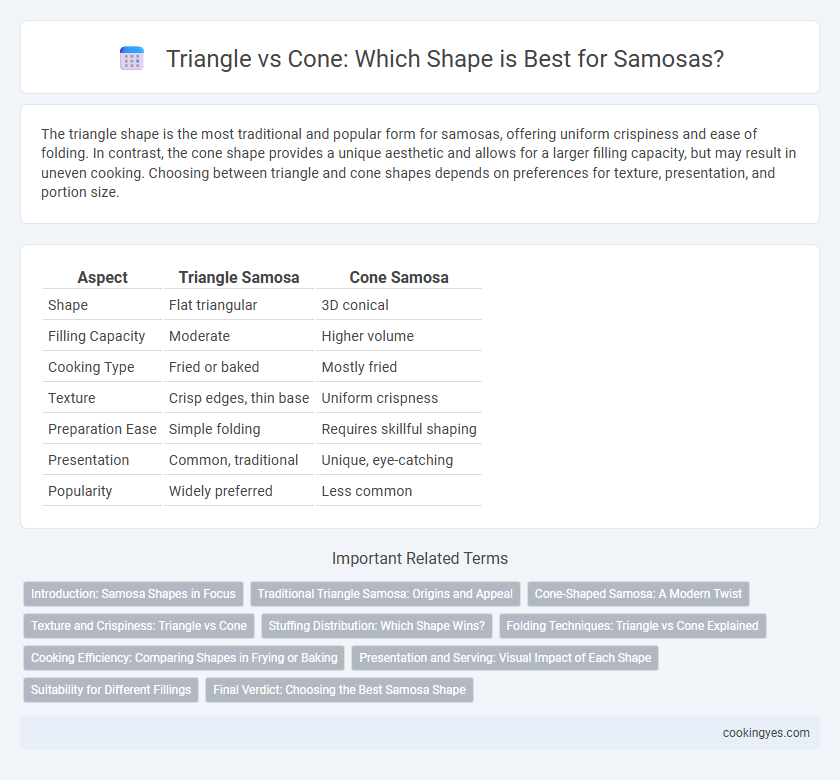The triangle shape is the most traditional and popular form for samosas, offering uniform crispiness and ease of folding. In contrast, the cone shape provides a unique aesthetic and allows for a larger filling capacity, but may result in uneven cooking. Choosing between triangle and cone shapes depends on preferences for texture, presentation, and portion size.
Table of Comparison
| Aspect | Triangle Samosa | Cone Samosa |
|---|---|---|
| Shape | Flat triangular | 3D conical |
| Filling Capacity | Moderate | Higher volume |
| Cooking Type | Fried or baked | Mostly fried |
| Texture | Crisp edges, thin base | Uniform crispness |
| Preparation Ease | Simple folding | Requires skillful shaping |
| Presentation | Common, traditional | Unique, eye-catching |
| Popularity | Widely preferred | Less common |
Introduction: Samosa Shapes in Focus
Samosas traditionally come in both triangle and cone shapes, each offering unique structural benefits and visual appeal. Triangle samosas provide even filling distribution and ease of folding, while cone-shaped samosas allow for a larger cavity to hold more stuffing, enhancing flavor density. Understanding the differences in shape helps optimize cooking techniques and presentation styles, catering to diverse culinary preferences.
Traditional Triangle Samosa: Origins and Appeal
Traditional triangle samosas trace their origins to Central Asia and the Indian subcontinent, where the triangular shape ensures even cooking and crispness. This classic form enhances the filling-to-crust ratio, offering a balanced bite that preserves the samosa's flaky texture. Its cultural appeal lies in its widespread recognition and association with authentic, homemade samosas served during festivals and family gatherings.
Cone-Shaped Samosa: A Modern Twist
Cone-shaped samosas offer a modern twist on traditional triangular samosas, enhancing both presentation and filling capacity. The conical design allows for even crispiness and an innovative way to pack more savory ingredients inside without compromising structural integrity. This shape is increasingly popular in contemporary culinary scenes, appealing to diners seeking unique textures and visual appeal.
Texture and Crispiness: Triangle vs Cone
Triangle-shaped samosas offer even heat distribution along their flat surfaces, resulting in a consistent texture and crispiness throughout the snack. Cone-shaped samosas create a varied cooking pattern, with the pointed tip crisping faster and the base remaining softer, producing a contrast in texture. The triangle shape favors uniform crunchiness, while the cone shape provides a dynamic blend of crisp and tender bites.
Stuffing Distribution: Which Shape Wins?
Triangle samosas offer more even stuffing distribution with their flat, layered structure, allowing the filling to spread uniformly across the pastry. Cone-shaped samosas tend to have uneven stuffing, often resulting in a dense, packed base and a hollow tip. For consistent and balanced filling, the triangle shape is the superior choice.
Folding Techniques: Triangle vs Cone Explained
Triangle-shaped samosas are created by folding a dough strip into consecutive triangular pockets, ensuring even filling distribution and crisp edges, while cone-shaped samosas involve rolling the dough into a cone and sealing the edges before filling, which allows for larger, more voluminous pockets ideal for varied stuffing. Triangle folding techniques provide structural integrity that prevents leakage during frying, whereas cone folding offers flexibility in portion size and easier filling insertion. Both methods impact the texture and cooking time, with triangles usually yielding a uniform crispness and cones delivering a fluffier interior.
Cooking Efficiency: Comparing Shapes in Frying or Baking
Triangle samosas offer more even heat distribution during frying or baking due to their flat surfaces, promoting uniform cooking and crispiness. Cone-shaped samosas tend to have thicker tips, which may require longer cooking times to ensure the filling is properly heated. Frying or baking efficiency improves with triangular shapes as they allow better oil contact and quicker heat penetration, reducing overall cooking time.
Presentation and Serving: Visual Impact of Each Shape
Triangle-shaped samosas offer a classic, crisp appearance that enhances traditional presentation, making them ideal for formal serving platters and buffet arrangements where uniformity is key. Cone-shaped samosas create a modern, elegant visual impact with their unique silhouette, perfect for upscale events and gourmet presentations that emphasize innovation. Both shapes influence portion perception and ease of handling, with triangles favoring stackability and cones fostering a single-serve, visually striking appeal.
Suitability for Different Fillings
Triangle-shaped samosas offer a more even distribution of fillings, making them ideal for thick or chunky mixtures like spiced potatoes and peas. Cone-shaped samosas provide a larger cavity, better suited for loose or saucy fillings such as minced meat or lentils. Both shapes impact frying uniformity and texture, influencing how well the filling retains moisture and flavor during cooking.
Final Verdict: Choosing the Best Samosa Shape
The triangle samosa shape offers a crispy, evenly cooked pastry with a perfect balance of filling to crust ratio, making it the traditional favorite. In contrast, the cone shape provides a more compact, modern presentation that retains heat longer and allows for unique stuffing variations. Choosing the best samosa shape depends on desired texture and serving style; for classic taste and crunch, the triangle excels, while the cone suits innovative flavors and portability.
Triangle vs Cone for Samosa shape Infographic

 cookingyes.com
cookingyes.com